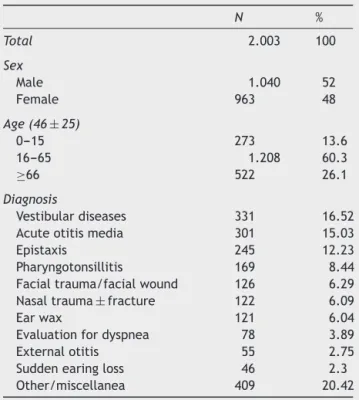BrazJOtorhinolaryngol.2014;80(6):549---550
Brazilian
Journal
of
OTORHINOLARYNGOLOGY
www.bjorl.org
LETTER
TO
THE
EDITOR
Comparison
of
two
different
epidemiological
profiles
of
otorhinolaryngology
emergencies
夽Comparac
¸ão
de
dois
perfis
epidemiológicos
distintos
de
emergências
otorrinolaringológicas
DearEditor,
Andrade et al. published on the May/June 2013 issue of this journal an interesting article on otorhinolaryngology (ENT) emergencies (‘‘Profile ofotorhinolaryngology emer-gencyunitcareinahighcomplexitypublichospital’’).1The
aimofthisletteristocompareandcommentwhathasbeen publishedtoourdata.
We retrospectively reviewed all patients sent for urgent/emergentconsultationtoourENTemergencyroom (ER)fromthegeneralemergencydepartment(ED)between twoperiodsoftime:fromJune1toJuly31,2012,andfrom November1toDecember31,2012.Inourhospital,the pro-tocol for referralsstates thatpatients donot have direct accesstotheENTERandtheyneedtobetriagedbytheED consultantwhoestablishesthelevelofurgency/emergency andtheneedforENTevaluation.Weconsideredallpatients referred for evaluation through this way, thus excluding patientstriagedingeneralpractice(GP)andreferredtous asplannedconsultationwithin24h.
Wecollected2021ENTemergencycases:amongthese, 18caseswereexcludedforlackofdata.Theremaining2003 caseswereincludedinthereview.Themeanageat presen-tationwas46±25yearsold,withamedianof45years.The demographicresultsandthetenmostcommondiagnosesfor referralareshowninTable1.
Whenclassifiedforsubspecialties,wefoundalowerrate of otological complaints (986 cases --- 49.23% vs. 65.41% reportedbyAndradeetal.1and62.27%reportedbyFurtado
etal.)2andahigherrateofheadandneckcomplaints(204
夽
Pleasecitethisarticleas:FarnetiP,MurriD,PiroddaA. Compari-sonoftwodifferentepidemiologicalprofilesofotorhinolaryngology emergencies.BrazJOtorhinolaryngol.2014;80:549---50.
Table 1 Demographic results and list of the ten most
prevalentdiagnoses.
N %
Total 2.003 100
Sex
Male 1.040 52
Female 963 48
Age(46±25)
0---15 273 13.6
16---65 1.208 60.3
≥66 522 26.1
Diagnosis
Vestibulardiseases 331 16.52
Acuteotitismedia 301 15.03
Epistaxis 245 12.23
Pharyngotonsillitis 169 8.44
Facialtrauma/facialwound 126 6.29
Nasaltrauma±fracture 122 6.09
Earwax 121 6.04
Evaluationfordyspnea 78 3.89
Externalotitis 55 2.75
Suddenearingloss 46 2.3
Other/miscellanea 409 20.42
cases---10.19%vs.1.79%1and2.07%,2respectively).The
per-centagevaluesofrhinologic(20.77vs.17.99%1and18.55%,2
respectively)and pharyngolaryngostomatologic complaints (19.82%vs.14.79%1and17.09%,2respectively)canbe
con-sidered similar. In our hospital, all patients triaged in theGeneralED anddiagnosedwithdizzinessor vestibular impairmentarereferredtotheENTED,unlesstheypresent withneurological symptoms. Thus, the vestibular disease is the most common diagnosis for ENT ED consultation and,in ourseries,accountedfor 16.52%(331cases)ofall referrals.Amongthesecases,30.4%werenegativefora ves-tibular deficit, 34.4% had a benign paroxysmal positional vertigo, 9.2% a vestibular neuritis, and 26% was related to other causes (Ménière’s disease, neurological or vas-cular symptoms, headache, etc.). This data highlights a differentapproachindiagnosisandtreatmentofvestibular diseasesanddemonstrateshowENTemergenciesratecan varydependingonthetypeofmanagementduringpatient
http://dx.doi.org/10.1016/j.bjorl.2014.08.009
550 LETTERTOTHEEDITOR
Table2 PercentageofcasesinthisseriesascomparedtoothersaccordingtotheetiologicalsubdivisionbyCuchiBroquetas.4
Etiology F.P.etal. Andradeetal. Furtadoetal.
Inflammatory/infection(%) 36.95 65.04 65.71
Sensorineuraldisorders(%) 21.85 13.66 2.28
Trauma(%) 17.49 4.47 7.9
Hemorrhages(%) 15.04 6.69 5.21
Respiratorydisorders(%) 4.63 0.04 0.10
Foreignbodies(%) 3.49 9.77 16.77
Functionaldisorders(%) 0.22 0.06 0
Tumordisorders(%) 0.33 0.24 1.65
Total(%) 100 100 100
triage.Inourinstitution,asatisfactorylevelofcompetence inotologyandneurotologyhasbeenreachedinordertoyield apromptadvicetogeneralandspecialistmedicalunites;the necessityofastrictlylinkednetofcooperationinthisfieldis particularlyconsidered.3Ourorganizationthusjustifiesthe
highernumberofpatientsassessedfor vestibulardiseases duringtheconsideredperiod.
Conversely,ourseriespresentedalowerrateof inflam-matorydiseasescomparedtootherstudies1,2althoughthis
diagnosisisstillthemostcommon(Table2).
The high rate for head and neck trauma consultation observedinourseries(17.49%,321cases)alsoreflectsthe hospitalprotocols,whichsuggestsENTED consultationfor alltheheadinjuriesorwound(exceptfortheorbitalarea). Patients are subsequently not referred to general, max-illofacial, or plastic surgeons as in other hospitals.4 This
protocolcanalsoexplainthehighernumberofepistaxisand facialandnasaltraumaamongthetenmostfrequent diag-noseswhencomparedtootherseries.1,2Alowerincidence
of foreignbodies could be explainedby the fact that, in ourhospital,thereferenceteamforconsultationand treat-mentforuppergastrointestinalforeignbodiesemergencies isthegastroenterological/endoscopic. Thus,allnose, ear, andmouthforeignbodiesarealwaysreferredtotheENTED. MostcasesofdyspneaarealsoprimarilyreferredtoENT ED,ratherthantoanesthesiologistsorpneumologists.This results in a higher rate of consultations when compared to other studies.1,2 In our series, 85 cases of respiratory
disorderswereobserved,butonlysix(7.1%)couldbe con-sideredtrueemergencies:twocasesofbilateralvocalcord palsythatrequiredemergencytracheotomyandfourcases oflaryngealedemathatrequiredhospitalization.
ThehospitaladmittancerateintheENTwardwas2.1% (42cases),mainlyduetoperitonsillarabscesses(18cases, 42.9%).
Finally,followingtheetiologicalclassificationdescribed byCuchiBroquetas,5weexcluded168cases(8.4%),which
couldnotbeconsideredastrueurgency/emergency accord-ingtoAndradeetal.,1suchasearwax,tinnitus.
We would like to highlight how the frequency of ENT emergencies could vary depending on the different man-agementandcompetencesofthespecialistaccordingtothe institutionalprotocols.
Conflicts
of
interest
Theauthorsdeclarenoconflictsofinterest.
References
1.Andrade JS,Albuquerque AM,Matos RC, Godofredo N deVR, PenidoNde O. Profileof otorhinolaryngology emergency unit careinahighcomplexitypublichospital.BrazJOtorhinolaryngol. 2013;79:312---6.
2.FurtadoPL,NakanishiM,RezendeGL,GranjeiroRC,OliveiraTS. Clinic-epidemiologicalanalysisofanOtorhinolaryngology Emer-gencyUnitCareinaTertiaryHospital.BrazJOtorhinolaryngol. 2011;77:426---31.
3.Pirodda A, Ferri GG,Borghi G. Early management of hearing and balance disorders: a review of literature and a proposal to overcome possible uncertainties. Minerva Med. 2010;101: 439---43.
4.YojanaS,MehtaK, GirishM.Epidemiological profileof otorhi-nolaryngolocical emergencies at a medical college, in rural areaofGujarat.IndianJOtolaryngolHeadNeckSurg.2012;64: 218---24.
5.CuchiBroquetas A. Urgencias en otorrinolaringologia: estudio etiologico.AnOtorrinolaringolIberoAm.1989;16:484---504.
PaoloFarnetia,b,∗,DomenicoMurrib, AntonioPiroddaa,b aDepartmentofExperimental,DiagnosticandSpecialty
Medicine,BolognaUniversityMedicalSchool,Bologna, Italy
bOtorhinolaryngologicClinic,Sant’Orsola-Malpighi
Hospital,Bologna,Italy
∗Correspondingauthor.

